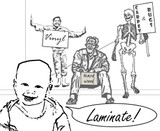A History of Laminate Flooring

In the history of flooring, laminate really is a newcomer. Vinyl has been with us for around 100 years, hardwood for multiple hundreds, and carpet for thousands (yes really, thousands!). Laminate flooring is around 30 years old, and it was designed by a countertop producer primarily to conserve unused, raw material and to utilize more production time at the plant, almost an afterthought. Now it’s one of the most popular kinds of flooring in the world. What happened?
The Swedish company now known as Pergo was founded in 1888 as Perstop, making vinegar. This lead to involvement in the business of chemicals more generally by 1923, and eventually production of laminated tabletops, countertops and wall panels that looked like wood, but cost a lot less than real hardwood products. Making this into a flooring product wasn’t a feasible option because people walk on floors more frequently than they do on tables, countertops and walls.
In 1974, Perstop acquired a competitor who had a factory which produced “bonded” products (things made of layers stuck together), which not only expanded their product line, but factored into their idea session in 1977, where the concept of laminated flooring was developed. Paper would be impregnated with resins, making it very wear resistant, and bonded with a board made of a composite of wear resistant materials. The result was a surface with 10 times the durability of the countertops. Enter laminate floor boards, going into production in 1979 and first sold in Sweden in 1980.
Right off the bat, laminate flooring was packaged in roughly four foot long planks, about 8 to a carton, contrasting with the standard eight foot long hardwood boards, packed in greater quantities, resulting in much heavier boxes. The cartons of laminate were manageable, and so was the material itself, giving rise to a new do-it-yourself flooring market in Sweden. In 1984, Perstop did a major marketing push in Sweden, and introduced laminate floors to Europe, starting in Scandinavian countries. Both efforts were very successful.

|

|
Initially made to replicate only wood, the new popularity of laminate flooring aroused a need for alternatives, so marble, slate, granite and stone looks were developed. In 1989, Perstop established its flooring department as its own company, given the name “Pergo”, an acronym of the company’s full name, Perstop Glov. The Laminate flooring itself was also called Pergo and, like Kleenex, the name became almost a generic term for the product.

|

|
Laminate flooring was durable, looked like wood, and was easy to install, so it quickly spread through northern Europe, being especially popular in Germany, and then filled that continent. In 1991 Perstop appeared at a trade fair in Germany, then the only manufacturer of laminate flooring. The following year there were seven, and by 1998 there were 34. This explosion in production lead to the need for a testing and classification method to inform customers, to be standardized across all laminate flooring products produced. In 1994, The Association of European Producers of Laminate Flooring, in Bonn, Germany, came up with a series of tests to measure various durability factors, fading, staining, scratching, burning etc., and called it the AC Rating. Today that remains the standard system for communication durability differences among different laminate flooring products.
Also in 1994, laminate flooring was introduced to North America, where sales eventually overtook those in Europe. In 1995 Asia got laminate. By 1996 Pergo had 100 stores in the U.S. Popularity came from the ease of both installation and maintenance. Even when glue was required between the boards, laminate was a floating floor. Today we may think that term means no use of glue at all, because with laminates that is now usually the case, but the term really only describes the fact that a floor isn’t being attached to the subfloor underneath it.
Glueless laminate flooring came about through two companies inventing locking systems for the floor planks. In 1996 Swedish company Valinge developed their system, branding the products Fiboloc and Alloc, and in 1997 a Belgian company called Unilin developed and patented their Uniclic system, which Pergo employed for their products. To date, any laminate locking system is still licensed by either or both of those companies. These locking systems simplified the installation process and eliminated the need for glue, amping up the do-it-yourself factor, making laminate flooring almost unparalleled in cost effectiveness. The popularity of laminate flooring grew so much that Perstop changed the parent company name to Pergo in 2000. Once an afterthought, within 20 years laminate flooring had come to define them.
Another feature that has improved throughout the life of laminate flooring as a product is photographic technology, so that the planks continue to look more and more realistic. Surface technologies have lead to distressed and hand-scraped stylings for their wood looks, and a feature known as “embossed in register.” That means that the surface actually adjusts according to the picture beneath it, adding to the realism of the look. Also, unlike almost every other type of floor, no dye lots are necessary with laminates. This means that you could buy additional floor planks that will be an exact match to your floor sometimes even years after your initial purchase. This is almost never an option with hardwood and ceramic tiles, even vinyl.
In 2004 the European Producers of Laminate Flooring (those folks in Bonn) reported that globally, an estimate of 2’460’629’921 square feet of laminate fllooring were sold that year (yes, they reported in meters. I’ve converted it for us). It’s popularity unquestionable, major manufacturers of other kinds of flooring are now producing laminates as well, including Armstrong, Bruce, Mohawk and Shaw.
Today The North American Laminate Flooring Association and The European Producers of Laminate Flooring exchange technical information and ideas with each other. They keep in touch with The European Committee for Standardization, who are formulating production standards for laminate flooring which will be legally enforceable, not submitted to voluntary, as are the current AC Ratings.
– – – –
David has written and made videos about flooring products and installation since 2011 at Floors To Your Home (.com), where he is also the PPC Manager, a Researcher, a Website & Marketing Strategy Team member, Videographer, Social Strategist, Photographer and all around Resource Jito. In my spare time I shoot and edit video, put together a podcast, explore film history, and mix music (as in ‘play with Beatles multi-tracks’). Connect with
W. David Lichty
Follow Team Floors To Your Home on Facebook

 Brown Tone
Brown Tone
 Red Tone
Red Tone
 Golden Tone
Golden Tone
 Gray Tone
Gray Tone
 Light Tone
Light Tone
 Medium Tone
Medium Tone
 Dark Tone
Dark Tone
 Brown Tone
Brown Tone
 Red Tone
Red Tone
 Golden Tone
Golden Tone
 Gray Tone
Gray Tone
 Light Tone
Light Tone
 Medium Tone
Medium Tone
 Dark Tone
Dark Tone
 Multi Color
Multi Color



